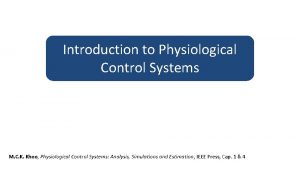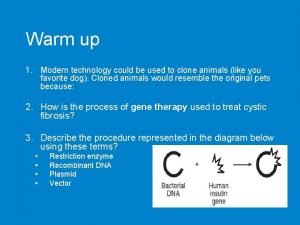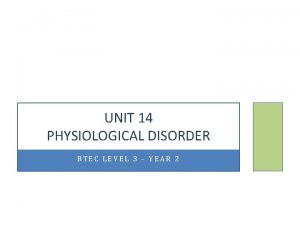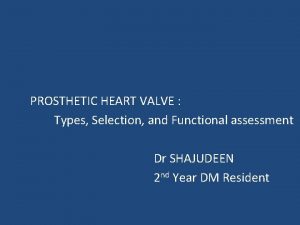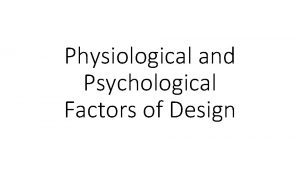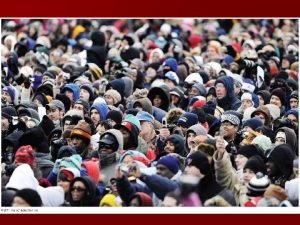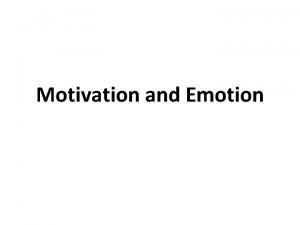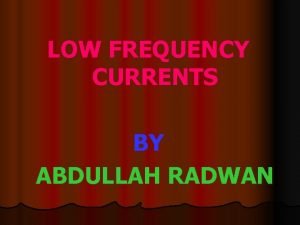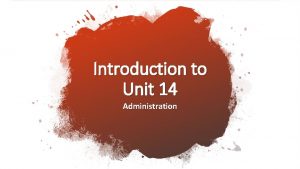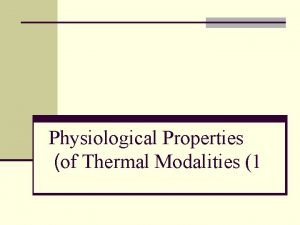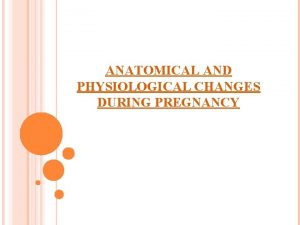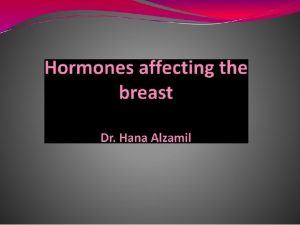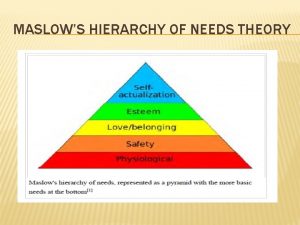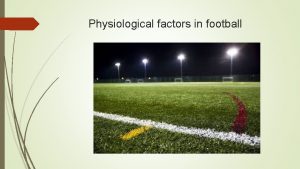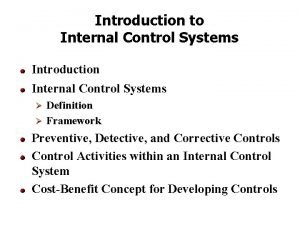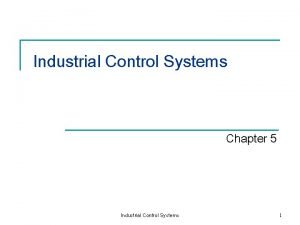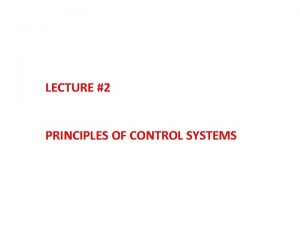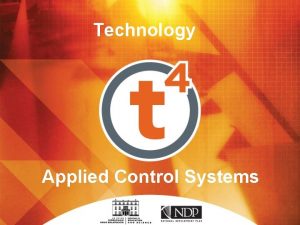Introduction to Physiological Control Systems M C K

























- Slides: 25

Introduction to Physiological Control Systems M. C. K. Khoo, Physiological Control Systems: Analysis, Simulations and Estimation, IEEE Press, Cap. 1 & 4

Preliminary considerations Control System: a collection of interconnected components that can be made to achieve a desired response in the face of external disturbances Servomechanism (e. g. robot arm) vs Regulator (thermostat) Open-Loop operation mode: the response of the system is determined only by the controlling input; they can perform satisfactorily as long as the external conditions do not affect the system much; e. g. “cold-blooded” animals (core body temperature, hence metabolism, does depend on external condition); preprogramming not always work. Closed-Loop operation mode: the system is self-regulatory, thanks to a feedback mechanism; Wiener "a method of controlling a system by reinserting into it the results of its past performance. " This strategy of control is ubiquitous throughout Nature: e. g. “warm-blooded” animals.

Open Loop and Closed-Loop

Historical background Claude Bernard (end of 19 th century) noted that the cells of higher organisms were always bathed in a fluid medium, e. g. , blood or lymph, and that the conditions of this environment were maintained with great stability in the face of disturbances to the overall physiology of the organism. "It is the fixity of the 'millieu interieur' which is the condition of free and independent life. “ … "all the vital mechanisms, however varied they may be, have only one object, that of preserving constant the conditions of life in the internal environment. " Walter Cannon (1939, The Wisdom of the Body) demonstrated systematically these concepts in the workings of various physiological processes, such as: -the regulation of adequate water and food supply through thirst and hunger sensors, -the role of the kidneys in regulating excess water and the maintenance of blood acid-base balance. He went on to coin the word homeostasis to describe the maintenance of relatively constant physiological conditions. ("stasis", not "statics, " although the end result was a relatively unchanging condition, the coordinated physiological processes that produce this state are highly dynamic. ) Grodins, Guyton, Coleman, Stark, … to name but a few names

Stretch Reflex (thigh)

Stretch Reflex (thigh)

Physiological vs Engineering Control Systems • Engineering control systems are finely designed to accomplish optimally a defined taks; physiological control systems are built for versatility and may be capable of serving several different functions (e. g. , respiratory system for gas exchange and heat removal) • An engineering control system is synthesized by the designer, the characteristics of its various components are generally known. The physiological control system usually consists of components that are unknown and difficult to analyze. Need to apply system identification techniques to determine how these various subsystems behave before we are able to proceed to analyzing the overall control system • There is an extensive degree of cross-coupling or interaction among different physiological control systems (e. g. , flexor involvement) • Physiological control systems, in general, are adaptive. This means that the system may be able to offset any change in output not only through feedback but also by allowing the controller or plant characteristics to change (e. g. , voluntarily induced stretch in the extensor muscles is no longer detected by the spindles. Thus, by this clever, adaptive arrangement, the muscle stretch reflex is basically neutralized) • Embedded feedback: negative feedback in this system is "built into" the plant characteristics (e. g. , increased efferent neural input produces a contraction of the extensor muscle, thereby acting to counteract the initial stretch) • Examples of positive feedbacks in physiological control systems (with constraints built in): action potential, ossitocine, coagulation. • Physiological systems are generally nonlinear

Stretch Reflex (thigh)

Stretch Reflex (thigh)

Stretch Reflex (other sites)

Stretch Reflex (arm)



Esercitazione 3: Riflesso del fuso neuromuscolare Ricavare analiticamente la funzione di trasferimento del modello del riflesso neuromuscolare ed implementare il corrispondente modello Simulink. Simulare il test clinico applicando una sollecitazione a gradino di ampiezza 5 e diagrammare l’andamento dell’angolo theta. Assumere J=0. 1 Kg*m^2, k=50 Nm, B=2 Nms, Td=0. 02 s, tau=1/300 s, eta=5 e considerare i seguenti tre casi per il valore del guadagno beta: 50, 100, 150. (Impostare i seguenti parametri per la simulazione: tempo iniziale 0; tempo finale 1; opzioni del solutore: fixed step, ode 3, fixed-step size 0. 001; tasking mode: Single. Tasking). Analizzare la stabilità del modello in funzione del parametro beta.

Pupillary Light Reflex

Pupillary Light Reflex


Pupillary Light Reflex Stark 1956

Pupillary Light Reflex Stark 1956

Pupillary Light Reflex Stark 1956

Pupillary Light Reflex Stark 1956 Opening the loop

Pupillary Light Reflex Stark 1956

Pupillary Light Reflex Stark 1956

Pupillary Light Reflex

Pupillary Light Reflex hyppus
 Hyppus
Hyppus Difference between analog and digital control system
Difference between analog and digital control system Introduction to digital control
Introduction to digital control Whats an adaptation
Whats an adaptation Masolow
Masolow Why is artificial selection used
Why is artificial selection used Unit 14 health and social care example
Unit 14 health and social care example Unit 14 physiological disorders
Unit 14 physiological disorders James-lange theory
James-lange theory Physiological phonetics
Physiological phonetics Physiological buffer system
Physiological buffer system Physiological process in reading
Physiological process in reading Dvi aortic valve
Dvi aortic valve High arithmetic density
High arithmetic density Physiological perspective
Physiological perspective Physiological effects of electricity on the human body
Physiological effects of electricity on the human body Physiological factors
Physiological factors Physiological factors affecting performance
Physiological factors affecting performance Arithmetic population density
Arithmetic population density Define primary and secondary motives
Define primary and secondary motives Smart bristow coil ppt
Smart bristow coil ppt Unit 14 physiological disorders assignment 1
Unit 14 physiological disorders assignment 1 Stepek ap human geo
Stepek ap human geo Phosphate buffer system equation
Phosphate buffer system equation Oxygen uptake pdhpe
Oxygen uptake pdhpe Physiological adaptation
Physiological adaptation
